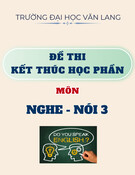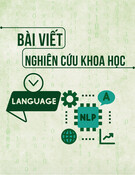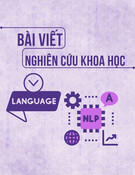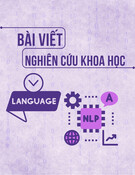Unit 1: Hello Unit 1: Hello
11
Unit 1: Hello Unit 1: Hello
I. AimI. Aim
II. Preparation II. Preparation
III. Teaching step III. Teaching step
22
I. Aims I. Aims
1. General knowledge 1. General knowledge
2. Skill 2. Skill
3. Attitude 3. Attitude
33
1. General knowledge: 1. General knowledge:
After this lesson, students can: After this lesson, students can:
Say hello and introduce themselves to Say hello and introduce themselves to strange people. strange people. Know people and countries around the Know people and countries around the world. world.
This part includes:: This part includes
44
1. General knowledge: 1. General knowledge:
a. Vocabulary
b. Proper names b. Proper names
c. c. Countries
Grammar d. Grammar
e. Expressions e. Expressions
55
a. Vocabulary:
Teacher (n): giáo viên Teacher (n): giáo viên
Very (adv): rất Very (adv): rất
Student (n): sinh viên Student (n): sinh viên
And (conj): và And (conj): và
From(prep): từ From(prep): từ
How (adv): thế nào, ra sao How (adv): thế nào, ra sao
Where (adv): ở đâu Where (adv): ở đâu
Fine (adj): khỏe, tốt Fine (adj): khỏe, tốt
66
Proper names: b.b. Proper names:
David Clark David Clark John John Peter Peter Linda Martin Linda Martin
77
Countries: c.c. Countries:
England: nước Anh England: nước Anh
Canada: nước Canada Canada: nước Canada
88
d. Grammar: d. Grammar:
(Đ i t PERSONAL PRONOUN (Đ i t PERSONAL PRONOUN
ạ ừ ạ ừ
nhân x ng): dùng đ ể nhân x ng): dùng đ ể
ư ư
thay th cho noun. thay th cho noun.
ế ế
c thay th b ng c thay th b ng
là II là
ượ ượ
ộ ộ
ế ằ ế ằ
+ I (ngôi th 1 s ít): tôi, t … ứ ố ớ + I (ngôi th 1 s ít): tôi, t … ứ ố ớ am a student. Ex: My name is ThuThu. . II am a student. Ex: My name is là m t tên riêng (noun) đ ThuThu là m t tên riêng (noun) đ ộ
ộm t pronoun. m t pronoun.
ứ ố ứ ố
ị ị
+ YOU (ngôi th 2 s ít): anh, ch , ông, bà, mày… + YOU (ngôi th 2 s ít): anh, ch , ông, bà, mày… is watching TV. Có ai đó h i: What are Ex: Ex: NamNam is watching TV. Có ai đó h i: What are
youyou
ỏ ỏ
doing, Nam? doing, Nam?
Nam là m t tên riêng (noun) đ Nam là m t tên riêng (noun) đ
c thay th b ng c thay th b ng
là youyou là
ộ ộ
ượ ượ
ế ằ ế ằ
ộ
ộm t pronoun. m t pronoun.
99
d. Grammar: d. Grammar:
+ HE, SHE (ngôi th 3 s ít): anh y, ch ị ứ + HE, SHE (ngôi th 3 s ít): anh y, ch ứ ị
ố ố
ấ ấ
y…ấy…ấ
c thay th b ng c thay th b ng
Ex: Hai is a worker. He is in work. Ex: Hai is a worker. He is in work. là m t ộ ế ằ HeHe là m t ộ là tên riêng đ HaiHai là tên riêng đ ế ằ
ượ ượ
pronoun. pronoun.
ứ ố ứ ố
ệ ệ
c dùng đ thay th cho hành c dùng đ thay th cho hành
ế ế
ể ể
+ IT (ngôi th 3 s ít): nó, vi c đó… + IT (ngôi th 3 s ít): nó, vi c đó… Ex: Nam works hard. It is very good. Ex: Nam works hard. It is very good. It là pronoun đ ượ It là pronoun đ ượ đ ng làm vi c chăm ch . ỉ ệ ộ đ ng làm vi c chăm ch . ỉ ệ ộ
1010
d. Grammar: d. Grammar:
ấ ấ
ụ ụ
ằ ằ
ể ể
ằ ằ ộ ộ
ạ ạ
ế ế ề ầ ề ầ ậ ậ
ệ ệ
Qua các thí d trên chúng ta th y r ng dùng Qua các thí d trên chúng ta th y r ng dùng pronoun đ thay th cho noun nh m tránh l p ặ pronoun đ thay th cho noun nh m tránh l p ặ i noun quá nhi u l n trong m t đo n d l ễ ạ i noun quá nhi u l n trong m t đo n d l ễ ạ gây nhàm chán; thu n ti n trong vi c nói và ệ gây nhàm chán; thu n ti n trong vi c nói và ệ t.ế t.ếvi vi
1111
Grammar d.d. Grammar
: có các To Be: có các
The present simple tense of
The present simple tense of To Be d ng:ạd ng:ạ + am+ am + is+ is + are+ are : thì, là, ở To Be: thì, là, ở To Be
1212
Grammar d.d. Grammar
Personal pronoun * * Personal pronoun II YouYou HeHe SheShe ItIt
The prensent simple tense of To Be * * The prensent simple tense of To Be amam areare isis isis isis
1313
e. Expression e. Expression
ế ế
ỏ
To be from: t … đ n, quê ừ ở To be from: t … đ n, quê ừ ở Thuan An-Binh Duong. am from Thuan An-Binh Duong. Ex: I am from Ex: I And you? = And how are you?: còn anh có And you? = And how are you?: còn anh có ỏkh e không? kh e không?
1414
I. Aims: I. Aims:
2. Skill: improve listening and speaking skill. 2. Skill: improve listening and speaking skill.
3. Attitude: students can give and reply to 3. Attitude: students can give and reply to
suggestions politely. suggestions politely.
1515
II. Preparation: II. Preparation:
1. References: Streamline English • 1. References: Streamline English Departures. Departures.
2. Method: communicative method. • 2. Method: communicative method.
3. Teaching aids: projector and computer. • 3. Teaching aids: projector and computer.
1616
III. Teaching steps: III. Teaching steps:
Steps Teacher’s activities Students’ activities
Times (min.)
Good morning, class. Good moring, teacher.
1. Greeting and checking attendance.
2. Warm up in 3’
Students say their mother tongue. Where are you from? What is your name?...
Give context when we meet strange people in work or class…what should we do in these case to make friends?
1717
3. New lesson Show some photos Look at photos 1’
Look at these photos Look at these photos
1818
Look at these photos Look at these photos
1919
III. Teaching steps: III. Teaching steps:
Steps Teacher’s activities Times
Students’ activities
the 4’
4. New lesson Look at photos
The persons in these photos meet to each other in the first time. And they are making friend. Ask students: Do you know how to do that in English?
1’
5. New lesson Listen carefully.
There are many ways to do that. This lesson give you one of those ways. Please, listen to the tape once.
and 5’
2020
6. New lesson Listen to the tape again sentence by sentence. Listen repeat.
Teacher’s activities: after introduce and make Teacher’s activities: after introduce and make friends. Photos below show that people in the friends. Photos below show that people in the photos are a team. They will have a good co photos are a team. They will have a good co operation. operation.
2121
III. Teaching steps: III. Teaching steps:
Steps Teacher’s activities Times
Students’ activities
5’
7.New lesson
Explain grammar, vocobulary and expressions. Teacher uses the slides above. down Write grammar and vocabulary.
5’
remind
Pronouce vocabulary and expressions.
Explain grammar, vocobulary and expressions. While using the slides above, teacher calls and asks each students pronounce vocabulay and remind expressions.
to smaller groups. 15’
8. New lesson Divide class Each group 3 or 4 students.
Do exercise 1 and exercise 2.
Work in group.
2222
Go around the class to guide and repair students’ mistakes.
III. Teaching steps: III. Teaching steps:
Steps Teacher’s activities Students’ activities Times
Listen to the tape once. Listen carefully.
9. New lesson
4’
sentence by
Repeat sentence.
2’
Ask studends look at the book and practice conversation as dialogue in the students’ book.
10. Home work
2323
the 1. Learn by heart expressions, vocabulary and grammar focus. 2. Listen to the tape again and repeat. 3. Do exercises 3 and 4.
THANK YOU THANK YOU
2424


























